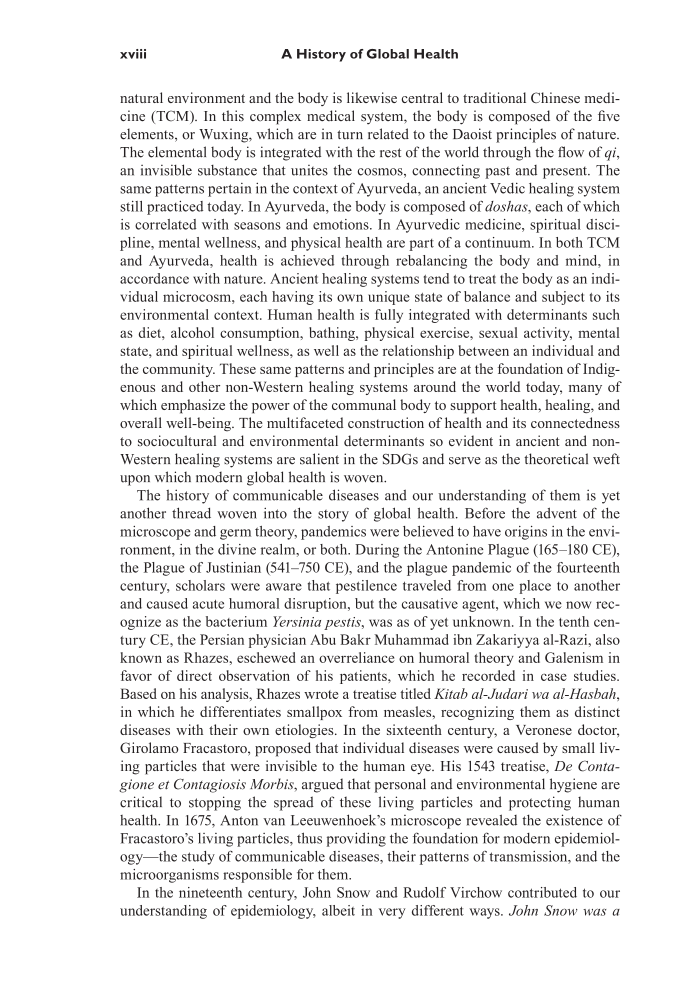xviii A History of Global Health natural environment and the body is likewise central to traditional Chinese medi- cine (TCM). In this complex medical system, the body is composed of the five elements, or Wuxing, which are in turn related to the Daoist principles of nature. The elemental body is integrated with the rest of the world through the flow of qi, an invisible substance that unites the cosmos, connecting past and present. The same patterns pertain in the context of Ayurveda, an ancient Vedic healing system still practiced today. In Ayurveda, the body is composed of doshas, each of which is correlated with seasons and emotions. In Ayurvedic medicine, spiritual disci- pline, mental wellness, and physical health are part of a continuum. In both TCM and Ayurveda, health is achieved through rebalancing the body and mind, in accordance with nature. Ancient healing systems tend to treat the body as an indi- vidual microcosm, each having its own unique state of balance and subject to its environmental context. Human health is fully integrated with determinants such as diet, alcohol consumption, bathing, physical exercise, sexual activity, mental state, and spiritual wellness, as well as the relationship between an individual and the community. These same patterns and principles are at the foundation of Indig- enous and other non-Western healing systems around the world today, many of which emphasize the power of the communal body to support health, healing, and overall well-being. The multifaceted construction of health and its connectedness to sociocultural and environmental determinants so evident in ancient and non- Western healing systems are salient in the SDGs and serve as the theoretical weft upon which modern global health is woven. The history of communicable diseases and our understanding of them is yet another thread woven into the story of global health. Before the advent of the microscope and germ theory, pandemics were believed to have origins in the envi- ronment, in the divine realm, or both. During the Antonine Plague (165–180 CE), the Plague of Justinian (541–750 CE), and the plague pandemic of the fourteenth century, scholars were aware that pestilence traveled from one place to another and caused acute humoral disruption, but the causative agent, which we now rec- ognize as the bacterium Yersinia pestis, was as of yet unknown. In the tenth cen- tury CE, the Persian physician Abu Bakr Muhammad ibn Zakariyya al-Razi, also known as Rhazes, eschewed an overreliance on humoral theory and Galenism in favor of direct observation of his patients, which he recorded in case studies. Based on his analysis, Rhazes wrote a treatise titled Kitab al-Judari wa al-Hasbah, in which he differentiates smallpox from measles, recognizing them as distinct diseases with their own etiologies. In the sixteenth century, a Veronese doctor, Girolamo Fracastoro, proposed that individual diseases were caused by small liv- ing particles that were invisible to the human eye. His 1543 treatise, De Conta- gione et Contagiosis Morbis, argued that personal and environmental hygiene are critical to stopping the spread of these living particles and protecting human health. In 1675, Anton van Leeuwenhoek’s microscope revealed the existence of Fracastoro’s living particles, thus providing the foundation for modern epidemiol- ogy—the study of communicable diseases, their patterns of transmission, and the microorganisms responsible for them. In the nineteenth century, John Snow and Rudolf Virchow contributed to our understanding of epidemiology, albeit in very different ways. John Snow was a
Document Details My Account Print multiple pages
Print
You have printed 0 times in the last 24 hours.
Your print count will reset on at .
You may print 0 more time(s) before then.
You may print a maximum of 0 pages at a time.















































































































































































































































































































































































































































































































































































































































































































































































































































































































































































































































































































